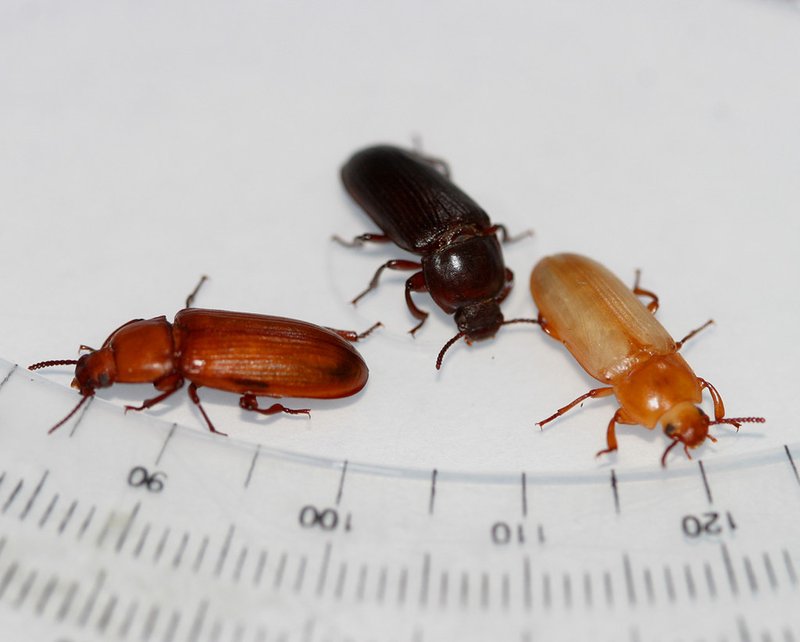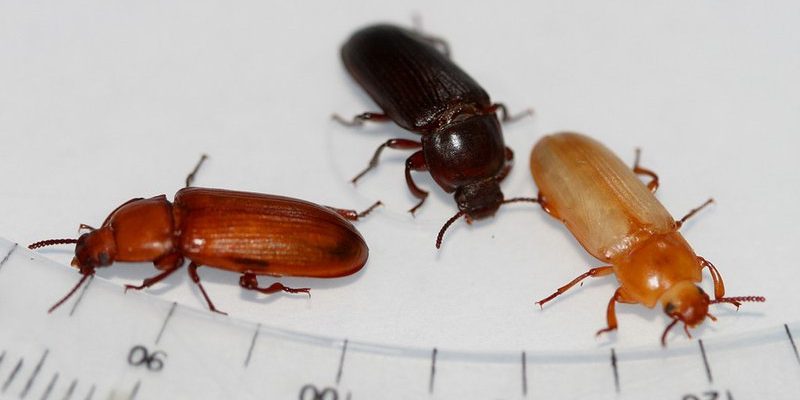
When you think of beetles, what comes to mind? Perhaps you picture shiny, colorful creatures buzzing around your garden. But one beetle often flies under the radar—the mealworm beetle. These unassuming insects, known scientifically as *Tenebrio molitor*, are more than just squishy larvae. They’re packed with interesting features and play a crucial role in both our ecosystem and our lives.
You might be wondering why mealworm beetles catch the attention of scientists, farmers, and even pet owners. It turns out that they have a lot to offer! These beetles are a vital part of the food chain and serve as a sustainable protein source for pets and livestock. The larvae, or mealworms, are even used in human food products. So, let’s dig a little deeper and uncover the secrets of this remarkable insect.
Physical Characteristics of Mealworm Beetles
Mealworm beetles are relatively small and possess unique features that make them stand out. Typically, they reach a length of about 1.25 inches (3–4 cm) when fully grown. Their bodies are elongated and often have a brownish-yellow color, which helps them blend into their surroundings. They can be recognized by their strong, tough exoskeletons that protect them from predators.
One of the distinctive characteristics of adult mealworm beetles is their hardened wing covers, known as elytra. These serve as protective shields for their delicate wings, allowing them to fly when necessary. In addition to their wings, mealworm beetles have long, segmented antennae that they use to navigate their environment, detect scents, and find food.
In terms of lifecycle, mealworm beetles undergo a fascinating transformation. They start as tiny eggs, hatching into larvae (the mealworms we often refer to), then progressing into pupae before emerging as fully developed beetles. This complete metamorphosis is not just impressive; it also allows them to adapt well to various environments.
Habitat and Distribution
Mealworm beetles are native to Europe but have spread across the globe, thanks to their adaptability. They thrive in warm and dry environments, often found in grain stores, animal feed, and compost piles. You are likely to find them in places where organic matter is plentiful, as they enjoy munching on decaying plant material, grains, and other organic debris.
These beetles are also quite resilient. They can tolerate different humidity levels and temperatures, which allows them to inhabit various ecosystems—from farms to storage facilities. However, they are not fond of extreme cold, so you won’t find them in frigid climates. In those cases, mealworm beetles prefer to stay in more temperate or tropical areas.
Interestingly, they play a significant role in nutrient recycling. As they feed on decomposing material, they help break it down and return valuable nutrients to the soil. This process is crucial for maintaining healthy ecosystems and promoting plant growth.
Dietary Habits
What do mealworm beetles like to eat? You might be surprised to learn that their diet is quite diverse! As larvae, mealworms primarily consume grains, cereal, and decaying plant matter. They are particularly fond of oats, wheat bran, and cornmeal, which provide them with the energy needed for growth. This diet is enriched with nutrients and fibers, making them excellent candidates for animal feed.
As adults, mealworm beetles continue to munch on organic materials, but their food preferences can evolve. They tend to favor decaying plant matter and can consume a variety of dried foods. When kept in captivity, many pet owners provide them with vegetable scraps, grains, and even specialized feed to ensure a balanced diet.
Interestingly, mealworm beetles are part of a larger trend in sustainable eating. Their larvae are increasingly popular as a protein source for both pets and humans. Rich in protein and healthy fats, they offer a nutritious option that has a smaller environmental footprint compared to traditional livestock.
Life Cycle of Mealworm Beetles
Understanding the lifecycle of mealworm beetles provides insight into their adaptability and resilience. The cycle begins when adult beetles mate and lay eggs in suitable environments. A female can lay up to 500 eggs at one time, which hatch into tiny larvae known as mealworms within a week or so.
These mealworms start small, but they grow rapidly, feeding on organic material as they do. Over a few months, they undergo several molts (shedding their skin) to accommodate their growth. This stage is crucial, as they can eat and store up energy for the next phase of their lifecycle.
Once the mealworms reach maturity, they transform into pupae—a stage where they don’t eat. Instead, their body undergoes remarkable changes, preparing them for their final form. After about two weeks, they emerge as adult beetles, ready to start the cycle all over again! This efficient reproduction strategy allows mealworm beetles to thrive in various conditions.
Benefits of Mealworm Beetles
Mealworm beetles are not just fascinating; they also offer several benefits that are hard to ignore. For starters, they are an excellent source of protein. Their larvae are high in essential nutrients, making them a popular choice for feeding pets, like reptiles and birds. With their growing popularity, mealworms are also making their way into human diets, viewed as a sustainable protein alternative.
Another benefit of mealworm beetles is their role in waste management. By consuming decaying material, they help break it down and return nutrients to the earth. This natural recycling process contributes to healthier soil and promotes plant growth. It’s a perfect example of nature’s way of keeping things balanced.
On top of that, mealworm beetles are relatively easy to farm. They require less space, water, and feed than traditional livestock, making them a sustainable choice for food production. With the world facing increasing food security challenges, mealworm beetles may provide a viable solution to supplement our diets without putting a strain on the environment.
Challenges and Conservation
Like many insects, mealworm beetles face their share of challenges. While they are adaptable, habitat loss due to urbanization and agricultural practices can threaten their populations. In addition, the use of pesticides in farming can negatively impact their survival. Protecting their habitats and promoting organic farming practices can help safeguard these beneficial insects.
Another concern is their use in the pet and food industries. While mealworms are raised for consumption, it’s essential to ensure that they are sourced sustainably and ethically. Over-farming can disrupt local ecosystems, so it’s crucial to promote responsible farming practices to maintain populations and biodiversity.
On a positive note, there is a growing awareness about the ecological role of mealworm beetles. Conservation efforts and sustainable farming practices are increasingly being implemented to protect them. By raising awareness about their benefits, we can help ensure that mealworm beetles thrive for generations to come.
How to Care for Mealworm Beetles at Home
Thinking about raising mealworm beetles at home? It’s easier than you might think! Start by creating a suitable habitat using a plastic container with a lid. Make sure to include ventilation holes, as these beetles need air to thrive. You can line the bottom with bran, oats, or even a mix of vegetables to provide them with food.
Maintaining the right temperature is crucial too! Mealworm beetles prefer warmer conditions, so aim for a temperature between 70–80°F (21–27°C). Keep them in a dark, dry environment, as they don’t like direct sunlight. Check in on them occasionally to make sure they have enough food and moisture.
Over time, you’ll start to notice the lifecycle in action—you may see eggs, mealworms, and eventually adult beetles. If you plan to use them for feeding purposes, make sure to rotate them out regularly to keep your supply fresh. Caring for mealworm beetles can be a rewarding experience, whether for education or for providing a sustainable food source for pets.
The mealworm beetle is far more than meets the eye. These tiny insects have an amazing life cycle, unique features, and multi-faceted benefits that contribute to our ecosystem. From their role in nutrient recycling to their potential as a sustainable protein source, mealworm beetles symbolize nature’s balance and ingenuity. So next time you see one, take a moment to appreciate the wonders of this small but mighty beetle!
FAQ
What is the lifespan of a mealworm beetle?
A mealworm beetle typically lives for about 3 to 4 months as an adult. However, their full lifecycle, from egg to adulthood, can take anywhere from 10 weeks to several months, depending on environmental conditions. Their lifespan can vary based on factors like temperature and food availability.
Can I keep mealworm beetles as pets?
Yes, many people keep mealworm beetles as pets, especially for species like reptiles and birds that enjoy eating them! They’re relatively low-maintenance, making them a great option for pet owners. Just ensure you provide a suitable habitat and proper care, and you’ll have a thriving little ecosystem!
Are mealworm beetles safe to eat?
Absolutely! Mealworm beetles are safe to eat and are increasingly being used in human food products. They are rich in protein, vitamins, and minerals. When sourcing mealworms for consumption, it’s essential to choose those that are farmed sustainably and free from pesticides or other harmful substances.
How do I get rid of mealworm beetles in my home?
If you find mealworm beetles in your house, the first step is to eliminate the source of their food and habitat. Check for stored grains or pet food that may be infested. Clean the area thoroughly and vacuum any visible beetles. If the infestation is severe, consider consulting a pest control professional for assistance.
Do mealworm beetles bite?
Mealworm beetles are not aggressive and typically do not bite humans. They lack the mouthparts necessary for biting and prefer to feed on organic matter instead. If you handle them, they may pinch slightly, but it’s harmless and usually not painful.
Can mealworm beetles fly?
Yes, adult mealworm beetles can fly! They possess wings that are protected by their hardened elytra. While they might not be frequent flyers, they can take to the air when necessary, especially to escape predators or find new food sources.
How do I tell the difference between mealworms and other larvae?
Mealworms are distinct in their appearance. They have a smooth, cylindrical body that is dark brown or yellowish in color. Compared to other larvae, mealworms are longer and have a more uniform shape. If you’re comparing them to other common larvae, such as sawfly or moth larvae, look for the lack of legs and their unique coloration.
Are mealworm beetles environmentally friendly?
Yes! Mealworm beetles are considered environmentally friendly due to their minimal resource requirements and role in waste decomposition. They eat organic waste and return nutrients to the soil, promoting a healthy ecosystem. Their ability to convert waste into high-quality protein makes them a sustainable food source for both animals and humans.
What temperature do mealworm beetles thrive in?
Mealworm beetles thrive best in warmer conditions, ideally between 70–80°F (21–27°C). Maintaining this temperature range will encourage healthy growth and reproduction. If temperatures drop too low, their development may slow down significantly.
Can mealworm beetles survive in the wild?
Yes, mealworm beetles can survive in the wild. They are adaptable and can live in various environments as long as they have access to food and shelter. In natural settings, they typically inhabit decomposing organic matter, which provides the sustenance they need. However, their ability to thrive in the wild may be impacted by extreme weather conditions or habitat loss.

